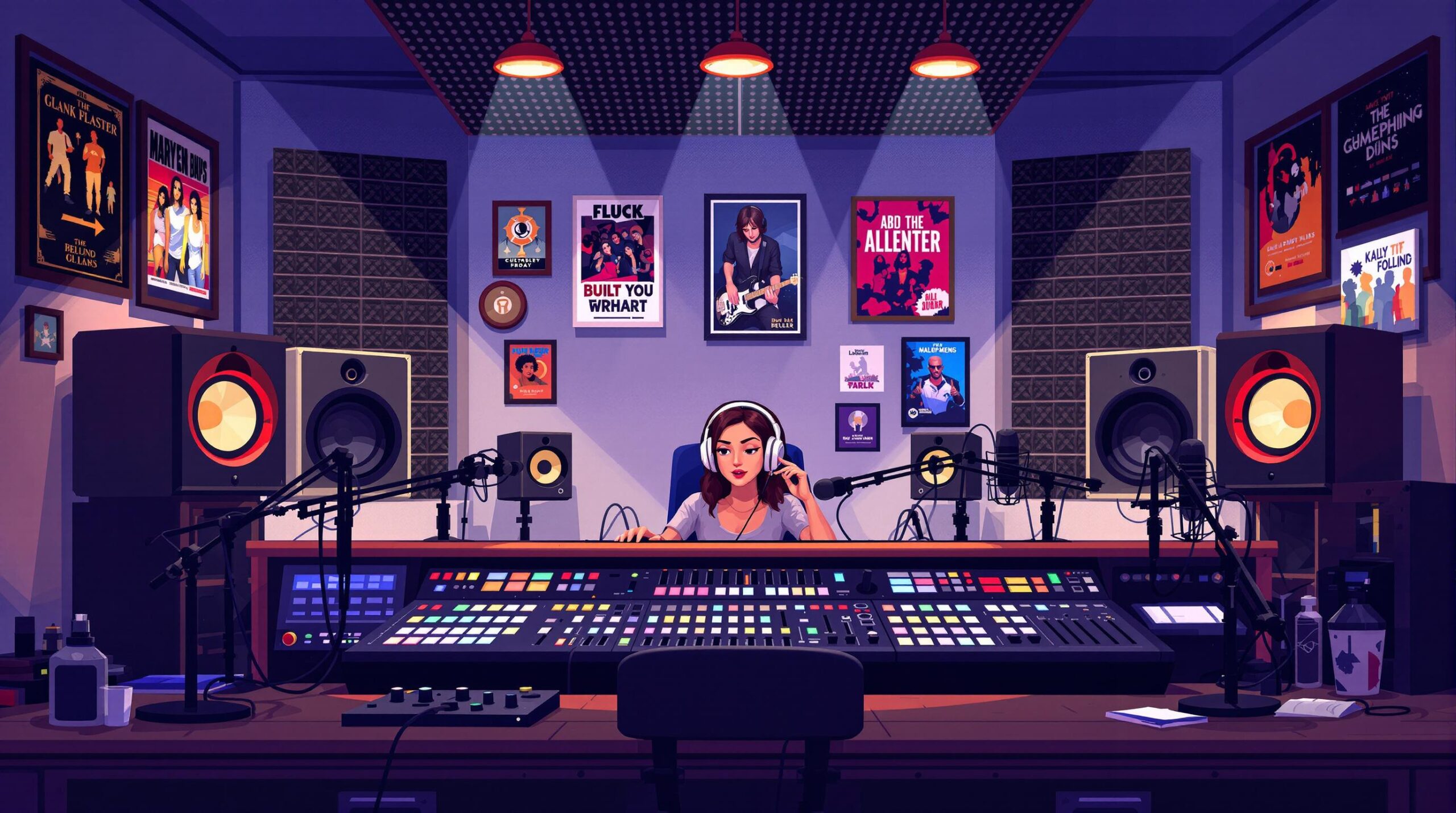-
Plan Ahead:
- Create demos, finalize song arrangements, and prepare your gear.
- Organize studio time and budget effectively.
-
Optimize Your Space:
- Treat your recording room with acoustic panels and bass traps.
- Position monitors and equipment correctly for clean sound.
-
Record Like a Pro:
- Use the right microphones and placement techniques for each instrument.
- Record in layers – starting with drums or rhythm and building up.
-
Mix and Master:
- Balance levels, cut problem frequencies, and apply compression.
- Master tracks for streaming platforms with proper loudness and peak levels.
Key Tip: Always leave enough headroom (around -6dB) during recording and mixing to avoid distortion.
This guide covers everything you need to transform raw recordings into polished, professional tracks. Let’s get started!
Everything You Need To Start Recording Music
Step 1: Planning Your Recording
Getting everything in place before you hit "record" is key for any professional recording project. Careful planning ensures your setup runs smoothly and captures the best performances.
Why Pre-Production Is Important
Pre-production isn’t just about practicing your songs – it’s about shaping the entire vision of your project. This stage usually focuses on three main areas:
- Song Development: Lock in arrangements, tempos, and key elements.
- Technical Planning: Decide on recording methods, choose your DAW (like Pro Tools, Logic Pro, or Ableton Live), create mock-ups, pick the right gear, and map out signal flow.
- Resource Management: Organize studio time, set your budget, and coordinate with musicians.
Creating Demos and Practice Sessions
Start by recording simple rough demos to sketch out your production. Use these to nail down the arrangement and tempo, then move on to technical rehearsals with a click track for better timing. Wrap up with full run-throughs to smooth out transitions. For intricate arrangements, MIDI mock-ups can help you visualize and refine the structure.
Pay attention to:
- Timing issues
- Gaps in the arrangement
- Potential microphone bleed
- Sections that need more practice
"Taking the time to thoroughly prepare and plan can help avoid these mistakes and ensure a smoother recording process."
With polished demos and focused rehearsals, you’ll be ready to dive into your recording session with confidence.
Step 2: Preparing Your Recording Space
Your recording space plays a big role in the quality of your sound. Whether you’re working from a home studio or a professional setup, getting your environment ready is crucial for clean, polished recordings.
Room Setup and Sound Treatment
Choose a room with good acoustics – one that reduces echo and reverb naturally. To improve sound quality, consider adding a few key elements:
- First Reflection Points: Place acoustic panels where sound initially bounces off walls or other surfaces.
- Bass Traps: Add these to the corners of the room to manage low-frequency sounds.
- Ceiling Treatment: Install diffusers or panels on the ceiling to cut down on overhead reflections.
If you’re on a budget, DIY solutions like wrapping Owens Corning 703 insulation in breathable fabric can work well for acoustic treatment.
Once your room is set, it’s time to arrange your recording gear.
Setting Up Your Recording Equipment
For accurate sound monitoring, proper equipment placement is essential. Arrange your monitors in an equilateral triangle:
- Place monitors at ear level.
- Angle the speakers inward so they form an equilateral triangle with your listening position.
- Keep the monitors away from walls to minimize unwanted reflections.
Invest in a reliable audio interface, like the Focusrite Scarlett series, which offers high-quality preamps and low latency.
Finally, tweak your DAW settings – adjust the buffer size and sample rate to strike a balance between processing power and latency.
sbb-itb-1c6af30
Step 3: Recording Methods and Skills
Now that your setup is ready, let’s dive into the techniques for capturing performances with clarity and precision.
Microphone Placement and Setup
The way you position your microphone can make or break your recording. Each instrument needs a tailored approach:
- Vocals: Use a large-diaphragm condenser mic (like the Neumann U87 or Shure SM7B). Position it slightly above the singer’s mouth and angle it downward at 45° to reduce plosives while capturing a full, rich sound.
- Acoustic Instruments: Follow the "3:1 rule" to avoid phase issues. For example, if the mic is 6 inches from the instrument, keep other mics at least 18 inches away.
"The choice of recording equipment, including microphones, preamps, and DAWs, plays a critical role in achieving professional sound quality. High-quality equipment can provide better signal-to-noise ratios, wider dynamic ranges, and more accurate sound reproduction, which are essential for professional recordings."
Once your mic placement is locked in, you’re ready to layer tracks effectively.
Recording Multiple Tracks
Start with the core elements like drums or rhythm guitar, and then layer additional instruments and vocals. Here’s a quick guide:
| Track Type | Method | Key Tip |
|---|---|---|
| Drums | Multi-mic setup | Close mic each drum and add overheads for balance |
| Bass | DI + Mic combo | Combine direct signal with amp tone for depth |
| Guitars | Close mic + Room mic | Blend for added space and texture |
| Vocals | Single mic, isolated | Prioritize a clean, dry signal |
For live recordings, use DI boxes to capture direct signals without losing the natural energy of the performance.
Setting Proper Audio Levels
Getting the levels right is critical for a clean mix. Keep these tips in mind:
- Aim for peaks between -12dB and -6dB on your DAW’s meters. This leaves enough headroom for dynamic changes.
- Avoid hitting 0dB to prevent digital clipping, which can ruin your recording.
Timing is also key. Use a click track to keep everything in sync when recording multiple layers.
For gain staging, follow this sequence:
- Microphone Preamp: Set the initial gain.
- Audio Interface: Ensure the signal remains clean.
- DAW Input: Adjust levels for optimal recording quality.
Step 4: Mixing and Mastering
Once your tracks are recorded and layered, it’s time to fine-tune them through mixing and mastering.
Mix Techniques: Levels, EQ, and Dynamics
Start by adjusting individual track levels to peak between -6dB and -3dB, leaving enough headroom for processing. Use both peak and RMS meters to monitor your levels accurately.
When working with EQ, focus on cutting problem frequencies before boosting others. Here’s a quick guide to managing frequencies:
| Frequency Range | Common Issues | Suggested Fix |
|---|---|---|
| 20-60 Hz | Rumble, mud | Use a high-pass filter to clean up the low end |
| 200-500 Hz | Boominess | Cut to reduce masking effects |
| 2-5 kHz | Harshness | Make cuts to avoid listener fatigue |
| 8-12 kHz | Dullness | Apply a gentle boost for clarity and brightness |
For compression, stick to ratios between 2:1 and 4:1, adjusting the threshold to achieve an average gain reduction of 2-3dB. To create depth, center elements like lead vocals and bass, while panning supporting instruments for a wide, dynamic sound. Use automation to add movement and keep the mix engaging.
These techniques help transform raw recordings into polished, professional-quality mixes.
Mastering for Release
Before mastering, ensure your mix peaks around -6dB, leaving room for additional processing.
Since streaming platforms normalize audio loudness, aim for these standard levels:
| Platform | LUFS Target | Peak Level |
|---|---|---|
| Spotify | -14 LUFS | -1 dBTP |
| Apple Music | -16 LUFS | -1 dBTP |
| YouTube | -14 LUFS | -1 dBTP |
Use tools like iZotope Ozone to streamline the mastering process. Focus on these steps:
- Stereo Enhancement: Widen the sound subtly without losing mono compatibility.
- EQ: Adjust for tonal balance and clarity.
- Multiband Compression: Control specific frequency ranges for a cleaner sound.
- Limiting: Set a ceiling at -1 dBTP to meet streaming platform standards.
Finally, test your masters across various playback systems – studio monitors, consumer speakers, and headphones – to ensure they sound consistent everywhere. Reference tracks from your genre can help guide your decisions on loudness and tonal balance.
Conclusion: Next Steps
Start by using a pre-production checklist that includes demos, practice runs, and equipment tests. This helps you avoid common issues like poor room acoustics or incorrect mic placement. Keep track of what works by documenting equipment setups and session details – this will make it easier to improve over time.
Focus on mastering one area at a time. If you’re new, prioritize perfecting mic placement and room setup before diving into advanced mixing techniques. Use reference tracks to shape your sound and compare your mixes to tracks in the same genre. Don’t hesitate to ask for feedback from experienced engineers – this can provide valuable insights for improvement.
Take a step-by-step approach: start with solid pre-production, fine-tune your room and gear, and build on the basics of recording, mixing, and mastering. These principles will help you produce polished, professional tracks that make an impact in today’s music scene. Each session is a chance to improve and move closer to creating your best work yet.

